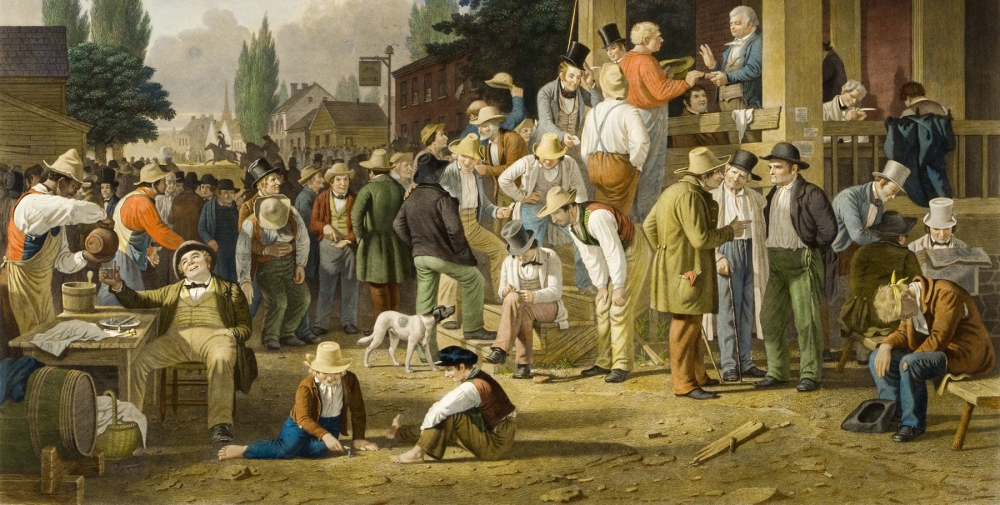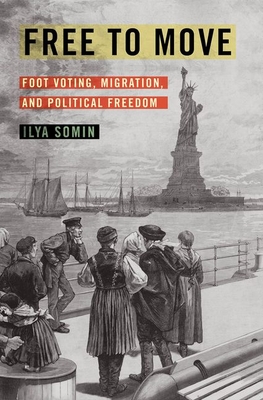Durham, NC – Ilya Somin is a professor at George Mason University. His recent book, Free to Move: Foot Voting, Migration, and Political Freedom, connects several topics that tend to be treated in isolation. Somin argues that human rights and human welfare would improve if we have more recognition of the right of people to move to new communities within their own country, to immigrate to new homes in other countries, and to make similar choices in the private sector. He calls this “foot voting,” or voting with your feet.
Porchers, of course, are skeptical of people leaving their homes for new communities based on such motives as short-term ambition, a restless spirit, or an unwillingness to make the compromises which make living in one’s original community better for everyone. But too often there are situations where one is faced with such persecution or poverty in one’s home that you must bid a sorrowful farewell to the old place and put down roots in a new community. That’s how many Americans started in America. It’s the situation faced by many modern migrants like the peoples of the old Christian homelands in the Middle East.
Somin, though, seems a tad too enthusiastic about people uprooting themselves. He speaks in these terms of people moving from their natal home to a new community: “The new home, presumably, is one they value more. And the more value people place on a resource, the more likely they are to invest in its maintenance and potential improvement.”
I quoted this red-meat passage to show that Somin is no localist. Yet this is not a reason to dismiss his book sight unseen. In addition to giving the case for pulling up stakes, Somin also gives his attention to the public-policy issues involving what he regards as arbitrary government restrictions on movement. He also denounces governmental policies which flatten out the diversity among different communities. This criticism is not necessarily because Somin is a localist; rather, it is part of his case that if people are given an array of different options regarding where to move, they can vote with their feet by selecting the areas they prefer, improving the condition of their families economically and socially. For example, if someone is tired of high-tax, high-regulation California, he can relocate to lower-tax, lower-regulation Texas.
In addition to benefits to individuals, argues Somin, this kind of migration can have public-policy benefits. Contrary to critics who say bad governments will stay bad if opponents of their policies simply leave instead of working politically to make policies better, Somin argues that these different dynamics—“voice” and “exit”—can work together. If a community’s leaders realize that their policies are driving people off and reducing the tax base, perhaps they’ll change the bad policies which led to so much out-migration. Communities can compete for desirable residents, fearing that if too many people flee they’ll have less tax revenue.
This presupposes that local communities derive their budgets from local taxes. Somin points out the danger that a central government—or even a regional government (like a state) cooperating with the central government—can offer “free” money to localities, so the localities don’t have to worry so much about local taxpayers. The localities won’t have to compete for taxpayers, and the value of foot-voting is reduced. So, on this issue Somin can make common cause with those who worry about distant authorities stamping out the distinctiveness, freedoms, and values of local communities.
On the question of international migration, Somin advocates what seems fairly close to an open-borders ideology. Migrants should be able to improve their lives by departing their home countries and choosing any other country they would prefer. As for specific policy changes, Somin would expand refugee law: in addition to letting refugees from political or religious persecution take shelter in other countries, he would give everyone who lives under an oppressive regime the presumptive right to resettle in another country. He would also provide refugee status to those fleeing economic oppression as well as specifically political oppression.
While public opinion is still getting educated up to Somin’s advanced perspective (you’d be right to detect some irony here), Somin would at least have countries like the U.S. increase immigration beyond current levels (Somin wrote this for the 2020 edition, during Trump levels of immigration). Somin would also empower regional governments to recruit immigrants and bring them in regardless of the wishes of the federal government. At the same time, he would keep the federal government’s power to bring immigrants into local communities without those communities having the right to object. Consistency would have had local communities be able to exclude immigrants as well as include them, but with his belief in a right to international migration, Somin is happy to have a one-way ratchet allowing either a local government or the federal government to bring immigrants into a community.
Somin considers and rejects various arguments for restricting immigration. His most interesting point is that arguments for restricting international migration would necessarily and logically work to limit internal migration within a particular country. Thus, to be consistent, advocates of America restricting immigration to protect jobs or the country’s cultural character must also advocate government restrictions on the movement of American citizens if their resettlement in another area of the country would depress wages, etc. But as Somin acknowledges, the right of an American citizen to have freedom of movement in his own country is a constitutional right, acknowledged even in the otherwise-narrow Slaughterhouse Cases in the U.S. Supreme Court. And there’s no benefit to being a citizen if your freedom of movement can be restrained like the freedom of movement of a noncitizen. That would abolish distinctions between those who are citizens and those who are not.
While Somin wants to rethink these distinctions, he doesn’t want to abolish them. Responding to concerns that immigrants may, once admitted to the ballot box, reshape the culture and change the country’s basic character, Somin suggests that the right to migration could be separated from the right to vote. When massive numbers of immigrants are let into the country under Somin’s plans, they could be denied the suffrage. Likewise they could be barred from welfare benefits to make sure that their incentive for coming is to seek work, not welfare. Somin’s distinctions may make sense, though it seems likely that some political party would come in and offer naturalizations and voting rights to the immigrants in exchange for various kinds of benefits. This is, after all, an approximately 200-year-old American tradition.
Somin’s arguments are more consistent and plausible in opposing centralization, both in the national and the global context. The right to international migration could be stripped of its value if a powerful world government—which would always in danger of becoming an open tyranny—could erase distinctions among countries the way a central national government might erase distinctions among local communities: with every place the same (in a bad way), there would be no value in exchanging one location for another. It is precisely as an open-borders internationalist that Somin opposes a planetwide central government: “Cosmopolitans who support free migration also have good reason to take a dim view of world government and other similar proposals.” Regrettably, as Somin notes, the rising generation, while sympathetic to Somin-style open borders, are also sympathetic to non-Somin-style world government. Ever the optimist, Somin hopes that growing open-borders enthusiasm can be harnessed without giving ground to the world-government enthusiasm among the same cohort.
Basically, Somin points out the benefits of allowing people to move from one home to another. He is so skeptical of government restrictions on that right that he even would allow greatly increasing the number of immigrants coming to this country, while leaving them disenfranchised if that’s the way to get support for his plan.
Enfranchisement may not have a great deal of value in Somin’s worldview anyway. In this book, as in earlier works, Somin cites lots of research to support his contention that voting (from Presidential elections right down to jury trials) reflects ignorance and bias on the part of the voters and is not a good vehicle for defending voters’ rational self-interest or community or national interests. The form of voting with the best effects, says Somin, is foot voting, where the migrants consider their specific interests and form specific answers to their problems, which the typical non-foot-voter allegedly can’t do.
We may grant that voter ignorance and bias may be a very serious problem in elections for larger jurisdictions: gubernatorial, Presidential, etc. But local people sitting on juries, in town meetings, etc. are capable of mastering relevant details and applying serious consideration to these details in search of a proper solution. If this ability has been diluted by centralization, then that centralization can be reversed—which Somin wants, albeit for his own reasons.
It would be nice if Somin (in addition to dialing back some of his strongest proposals) would see migration (national and international) as a remedy for intolerable situations, a lesser evil, not a desirable thing in itself. Those who aren’t oppressed or impoverished but are tempted to leave their ancestral homes through ambition or restlessness, might stop and think. War, violence, and failed governments will continue to push people out of their homes, and lesser causes may sometimes make foot-voting a necessary evil. On the other hand, the growth of remote-work opportunities may paradoxically encourage more local loyalty by allowing people to work from home—a home perhaps remote from their work but close to their grandparents’ graves.
Author’s Note: The publisher kindly sent me a review copy of the 2020 edition of this work. I had been hoping for a copy of the revised 2021 edition, which includes some updated analysis, some of it probably responding to the pandemic. This review is only of the 2020 edition.







4 comments
Martin
It’s a good review of what appears to be a complex book that I now have no interest in reading. How many times can one uproot and move, compared to the number of times one goes to a ballot box? It’s meaningful to vote with one’s feet, and can be done in a micro-way when choosing supermarkets, etc. but it’s very clunky compared to the polls.
“He would also provide refugee status to those fleeing economic oppression as well as specifically political oppression.”
This is just sloppy thinking. What does economic oppression actually mean? That I’m not as rich as I should be, and it’s the fault of someone else? Seriously.
Christian
I think Longley’s final paragraph is key – “foot voting” should be seen as a measure of last resort. Otherwise, it becomes an easy “solution” for those looking to dodge hard problems. Appalchia has lost its economic base with the decline of extractive industries? Not to worry – former coal miners and their families can all just move. No need to think about what might be done to promote new opportunities that would enable communities to survive in place.
I once had a colleague who was legitimately astonished that everyone in Eastern Kentucky hadn’t already moved to West Texas. The notion that internal migration is a desirable solution to regional problems seems very misguided.
David Naas
On the one hand, there is no one who currently lives in the Americas but had ancestors who came here from somewhere else, we are truly a “nation of immigrants”. (Including the “Native Americans”, whose ancestors came over the land bridge from Siberia to Alaska a few tens of thousands of years before the rest of us arrived.)
On the other hand, the rootlessness of Americans, and too many others, is driven, not by overweening desire to fulfill themselves, but by some form of social and politico-economic pressure. At this point, it has become habitual, since almost no one today really understands (or desires) the values of Place and Community.
On the gripping hand, Americans think living in the same place for 20 years is a long, long time. In parts of Europe, buildings and families have been rooted for longer than there has been a United States, and look on our “society” as a constant churn of nomads. (Having been in the same house for the last 30 years, so that I can find my way about in the dark, I feel relatively stable, but “back home” my family has been mostly in place for over a century and a half, with those who have gone gypsy eventually returning to die.)
Like those national ideals of Life, Liberty, and Pursuit of Happiness, as the more “conservative” goals of Stability, Continuity, and Reform, even as the desire for permanent Things the Good, the True, the Beautiful, we must confess our inclination for rootedness and localism is yet in the aspirational stage.
Realization may not come for years, if ever, but that is no reason not to go on trying.
Aaron
This is a good example of why libertarians are always going to be problematic allies. I’ve followed Volokh’s blog over at “Reason” for a number years now, just as one way of keeping up on what the libertarians are thinking about things. Somin writes for that blog quite a bit, and I remember his posts in and around the release of his book inspiring exactly the same modes of skepticism present in this review. I wonder if it has occurred to Somin that Russian peasants “foot-voted” for centuries, to get away from the expanding power of the Russian Empire, and mostly what they go for their trouble was more Russian Empire. As Deneen has observed previously, the problem with libertarianism is that what you get is a more powerful centralized government to enforce it.
Comments are closed.